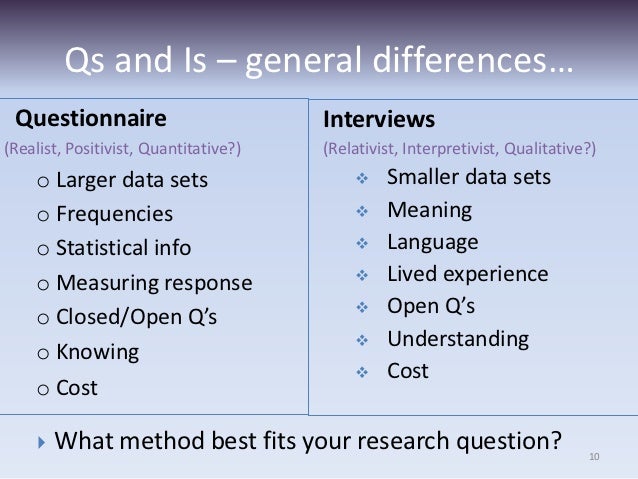Difference Between Positivism And Interpretivism Pdf Files
• • • What is the difference between Positivist and Interpretivist? 1 year ago • • • • • 9148 views • Positivism and Interpretivism are two very important, and very different approaches to sociological research and study. Here are some key features of these two positions, which highlight the fundamental differences between them. Positivism 1) Associated with ‘scientific method’ - Positivists believe the social sciences can be as rigorously scientific as the natural sciences - Theories and ‘hypotheses’ can be generated and then tested using direct observation or ‘empirical’ research - Positivists are most likely to use ‘quantitative’ analysis using statistical methods etc 2) Believe in value-free, objective research - Using interpretivist research methods make it impossible to see beyond our own personal baises and experiences. - A scientific methodology allows us to gain objective, trustworthy and generalisable data, more beneficial to sociological theory. Interpretivism 1) Our knowledge of the world is ‘socially constructed’ - Knowledge is not ‘objective’ and ‘value-free', but is transmitted to us through ideas, discourses and experiences.
- There are no simple 'facts', only interpretations of the world. 2) The type of ‘objective’ and scientific social science which positivists attempt is simply not possible. Tujamo Hey Mister Mp3 Download Zippy Andra. - Attempting to discover 'facts' wastes time that could be spent attempting to udnerstand the ways in which different people interpret the world.
- It is not possible to make valid causal statements or predictions about the social world. About the author Evan J. Is an online tutor with MyTutor studying at Birmingham University.

• Distinguish between exploratory, descriptive Chapter 4: Research methodology and design. Explain the relevance for business research of philosophical perspectives such as positivism, realism, pragmatism, interpretivism, objectivism, and. Positivism and scientific method. Pdf), Text File (.

Extracts from this document. Introduction In what ways and to what extent are the positivist and interpretive approaches to sociological research different?
The sociological ideals followed by the positivist are the antithesis of those chosen by the interpretivist. The positivist expects to always find that, as Condorcet described, 'everywhere one must reach the same results with the same methods for the truth is one for everybody, because nature is everywhere subject to the same laws' [1]. Whereas for the interpretivist 'reality really is in the eye of the beholder'.[2] The Positivist standpoint is really that of the early sociologists who tried to attach social laws to humanity in the same way Newton's experiments gave us the theory of gravity. As Auguste Comte claimed in 1842, 'instead of systems of belief in which the destiny of an individual was in the unintelligible hands of God or rulers, scientific knowledge would make it possible for an individual to understand nature and society, and with this knowledge to determine, in freedom, their own future.'
[7] These newly formed social scientists tried to use statistics and precise measurements to answer the problems of society. Karl Popper saw that a very precise hypothesis must be made1, that can be tested and re-tested to 'make precise predictions on the basis of the theory.' Middle They will use peoples words and expressions of feelings without generalisation or representation. They work with small numbers of people and hope to achieve validity6 in their data. The Interpretivists prefer to ingratiate themselves into their subject's society and allow members to tell their own story in their own way, such as when 'Karen Sharpe studied the lives of prostitutes by acting as a 'secretary' for them.'
[21] By gradually befriending these women and putting herself in a position where they would learn to trust her she assumed she would have had more success in finding what she wanted to know than by approaching her research in a more structured manner. It is, perhaps, strange that when the two methodologies are so different, their main criticism should be the same: that both forms are subjective. The surveys and questionnaires of the Positivist fall foul of the mind-set of the writer. The questions set will not always have a relevance to all who take part in the research and the multiple choice answers cannot possibly take into account that which is appropriate to every individual, therefore the researcher's view of social reality has influenced the outcome of the research. The very choice of subject has to have been influenced by the researcher's viewpoints.
Conclusion 5 Milgram's experiment consisted of a number of teachers and 1 learner. The teachers were told that the learner knew the answers to their questions but refused to give them, and was to be shocked by anything from 15 - 450 volts. The learner was an actor and no real shocks were given, but most subjects gave what they thought was a 450 volt shock, without hesitation as they had been told to do so by an authority figure.
6 Validity = 'The ability of a test or research method to measure what it sets out to measure. For example, IQ tests are often contested with regard to their validity, as there is no consensus over what IQ tests are actually measuring.' [20] 7 Elton Mayo analysed the results of an experiment at the Hawthorne Works of the Western Electric Company in 1933. Worker Productivity was being tested by the manipulation of variables such as lighting, temperature and length of breaks.
However, it appeared that, as productivity increased in all cases, it was the employees knowledge that such tests were taking place that was the main catalyst. 8 Psychiatrist, Topeka Kansas, 1893-1990. He argued that crime was preventable through psychiatric treatment.[23] 9 'British social theorist, born 1938. Theory of 'saturation' solved problem of whether individual acts, or major social forces, shape society, by asserting that it is human agency which continuously reproduces social structure.'